The Treasury of Iran National Jewels is located in the highly secured basement of the Central Bank of the Islamic Republic of Iran, at the heart of the City of Tehran. If you’re travelling to Iran, Iran National Jewelry museum must be at your top 3 to visit. With each Tehran Tour, we operate through Hi Tehran Hostel, we get fascinated by the glory of this Treasury. The opening hours and days of Treasury of National Jewels is very limited due to high security, and the fact that you have to pass through the central bank of Iran and some security gates, and also, there’s a limitation for the duration of visits. Hence, we thought to introduce the items and cases of Iran National Jewels museum, for those who want to have a clue prior to their visit during their Iran Tours.
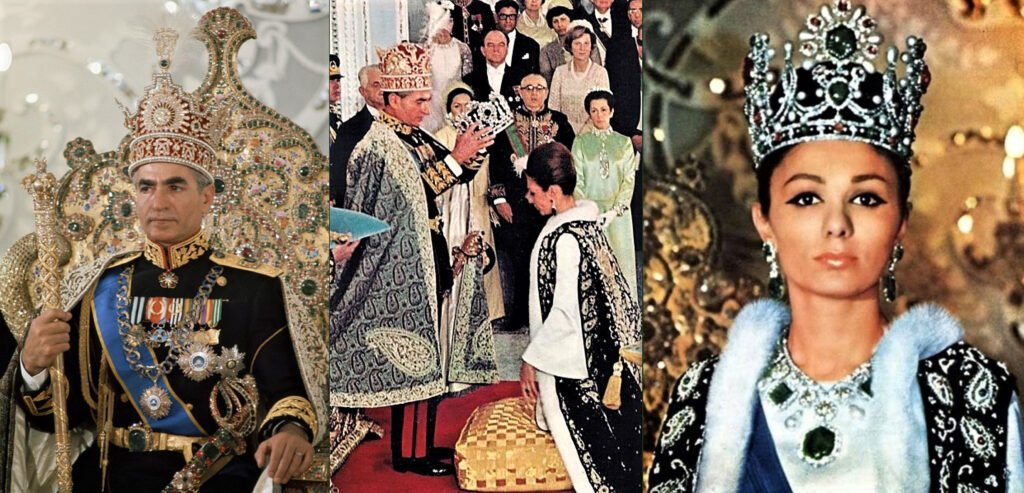
Introduction
The incomparable “Treasury of Iran National Jewels”, which is open to public, is the collection of the most expensive jewels of the world, collected over centuries.
Every piece of this collection is a reflection of the tumultuous history of this great nation, and the result of the creativity and artistry of the residents of this land. Each piece recalls memories of bitter-sweet victories and defeats, of the pride and arrogance of the rulers with their own mind set.
If you are eager to see the extraordinary jewels and gems in Iran National Jewelry Museum, it means you crave for the greatness of history and culture. Since, this treasury depicts the culture and civilization of the Iranian people who have had an adventurous past and survived along it with glory.
The value of the objects in the Treasury of Iran National Jewels, is not limited to their economic value, but is also a reflection of the creativity and taste of Iranian craftsmen and artists over the different eras of history, and represents the artistic and cultural heritage of the glorious country of Iran. These jewels and rarities were decorations for the rulers during the past eras, and often showed the lorry and extravagance of their courts, as well as their power and wealth.
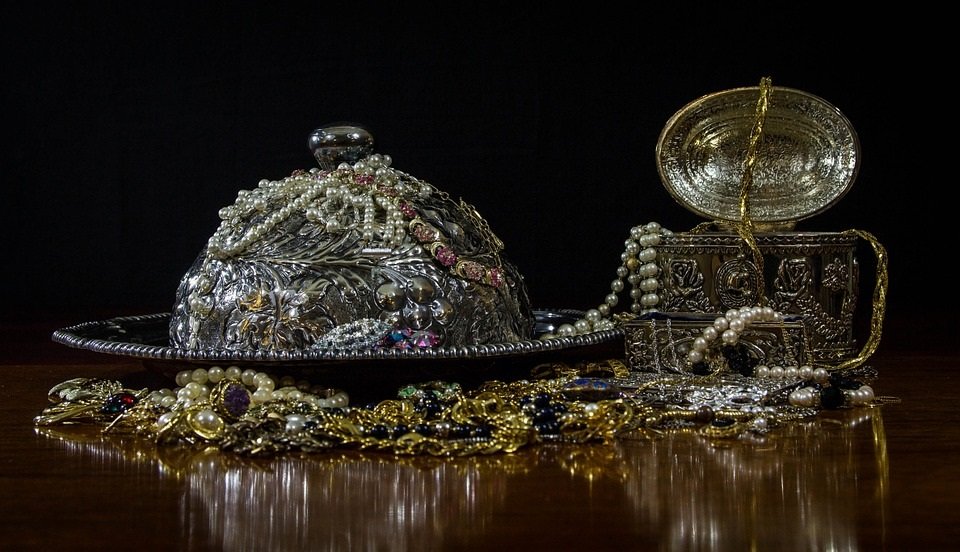
There is no information about the quality and quantity of the treasuries before the Safavid period. It can be said that the recorded history of the Treasury of Iran Jewels, began with the Safavid monarchs. In short, the history of the amassment of the present collection is as follows:
Before the Safavid dynasty, certain jewels existed in the government treasuries. But, it was with the Safavid dynasty that foreign travelers (Jean Baptiste Tavernier, Chevalier Chardin, the Shirley Brothers, George Mainwaring and others) began to mention these treasuries. The Safavid monarchs, over two centuries (907 to 1148 LH* equal to about 1502 to 1735 A.D.), started to collect rare and beautiful gems. The gem specialists of the Safavid court brought fine stones to Isfahan, the capital of Iran at that time from the markets of India, the Ottoman Empire and European countries like France and Italy.
After the rule of Shah Sultan Hossein and the entry of Mahmoud the Afghan to Iran, the treasury was scattered and some of the jewels were taken by Mahmoud the Afghan and transferred to Ashraf the Afghan. After the entry of Shah Tahmasb II and Nadir to Isfahan, these jewels fell into the hands of Nadir, and thus were preserved inside the country. Later, in order to reign the jewels that had been transported to India, Nadir wrote several letters to the Indian court, but did not receive any favorable reply. After Nadir’s victory in India 1158 LH (1745 A.D.), Mohammad Shah delivered cash amounts, jewels and weapons to Nadir as booty. Part of the treasures which were obtained in India never reached Iran, and were lost during transportation. According to the tradition of that time, after returning to Iran, Nadir sent part of the booty as gifts to neighboring rulers. He also presented some beautiful and rare objects to the Holly Shrine of Imam Reza, while some were distributed among the soldiers of his army.
After the assassination of Nadir in 1160 LH (1747 A.D), Ahmad beg Afghan Abdali, one of his commanders, looted the treasury of Nadir. One of the famous jewels that left Iran at this time and never returned was the famous Kooh-e-Nur (Mountain of Light) diamond. This diamond passed on to the hands of the East India Company, and in 1266 LH (1850 A.D.) it was given to Queen Victoria as a gift. After this event, there was no major change in the treasury until the time of Qajar dynasty. During the Qajar period, the treasury was collected and recorded. Some of the stones were mounted on the Kiani Crown, the Nadir Throne, the Globe of Jewels and the Peacock Throne (or the Sun Throne).
Two other items that were gradually added to this treasury, are the turquoises, the genuine precious stone of Iran, extracted from the local turquoise mines, and the other are pearls, hunted from the Persian Gulf. According to the law approved on 25th Aban 1316 SH (1937 A.D.) a major portion of the treasury was transferred to Bank Melli Iran, and formed part of the reserves for note issues, and later became collateral for government liabilities to the Bank. The present collection was constructed in 1334 SH (1955 A.D.) In 1339 SH (1960 A.D.), by the establishment of Bank Markazi Iran (The Central Bank of Iran), the treasury was transferred and deposited with the Central Bank. Until now, the Central Bank of Iran, safeguard it.
During the Islamic revolution of Iran and the imposed war, the devoted employees of the Central Bank protected this peerless collection. There is always one important unanswered question about this treasury: How much is the value of this collection?
Since this collection contains gems that are unique in the world, no one knows the answer to this question. From the artistic viewpoint to historical background, all measures the value of this treasury that even the most expert evaluators of the world have not been able to calculate the price of this collection.
TREASURY OF IRAN NATIONAL JEWELS: Famous Pieces
CASE NO.1
This case contains a number of gold and jeweled objects including Kalyans (waterpipes or nargile), dish covers, flower vases, mirrors, and other objects.
- Items 14, 18 & 46: These enameled rings are decorations for the horses’ tails.
- Item 24: Gold and enameled container decorated with an emerald.
- Items 32 & 36: Jadite ladles jeweled handles.
- Item 44: A saddle horn.
CASE NO.2
This case contains several jeweled dish-covers, Kalyans (Shisha), boxes, enameled decanters and snuff boxes.
- Item 5: Gold decanter with outstanding enamel work containing pictures of flowers and birds. On the upper half, there are pictures of women. The decanter is one of the best examples of Iranian enamel work.
- Item 18: Gold box decorated with diamonds, is a gift from Umberto King of Italy (1878-1900 A.D.) to Nasser-ed-din Shah.
- Item 27: This bejeweled waterpipe has a special design. The smoke exit is like the head of a dragon. The Qajar Kings used this waterpipe during ceremonial occasions.
CASE NO.3
In this case, a candlestick, several kalyan heads, coffee cup holders and dish-covers are displayed.
- Item 1: This golden candlestick is decorated with spinels, diamonds, emeralds, rubies, tassels of pearls and emeralds. It was used with its twin displayed in case No.32, on either side of the Peacock Throne (The Sun Throne) during ceremonial occasions in the Golestan Palace.
CASE NO.4
In this case, various parts of water pipes, tea pots, coffee pots, enameled golden tray, and other household items are displayed.
- Item 38: An incense burner
- Item 35: A saddle horn decorated with diamonds, rubies and blue enamel.
- Item 13: The coconut shaped jar of a waterpipe is made of a beautifully carved ostrich eggshell.

Case No.2: Enamelled Decanter Made end of 18th Century 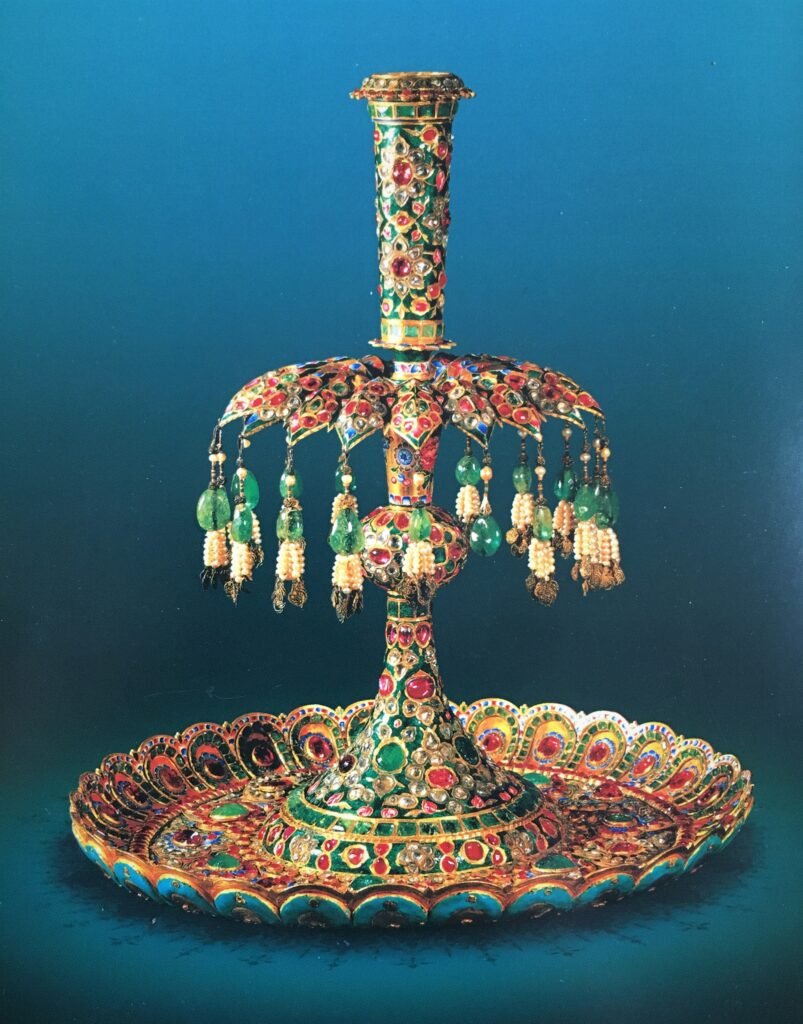
Case No.3: Half of a pair of Candle Sticks Made Early 19th Century 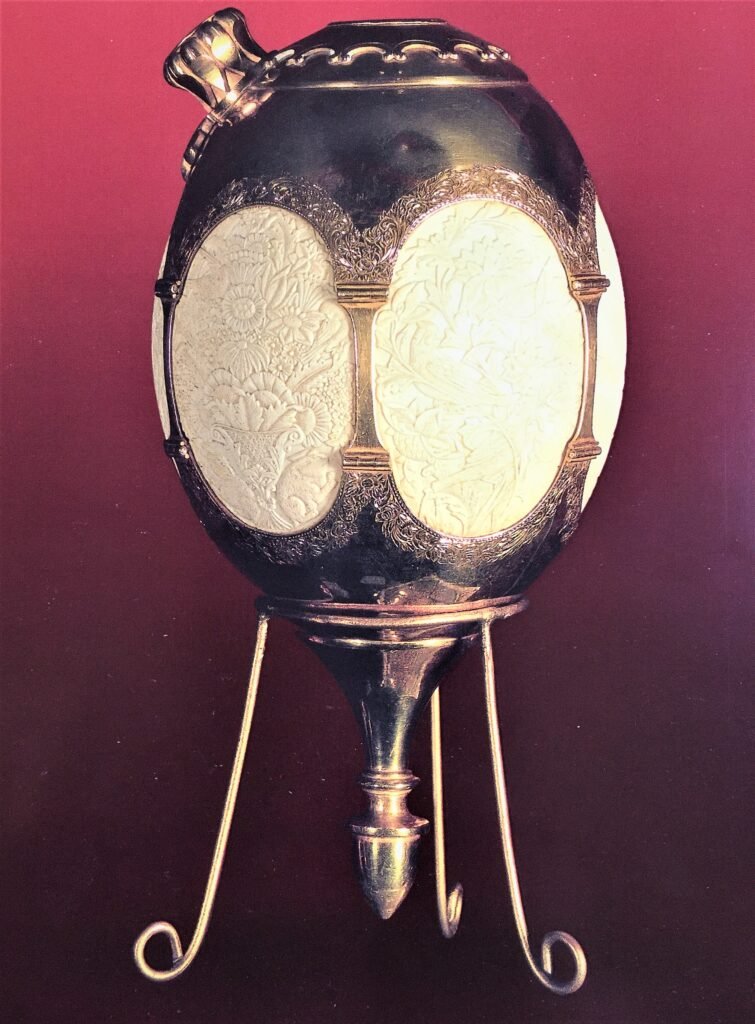
Case No.4: Ostrich Egg Shell Water Section of a Nargile
CASE NO.5
This case is completely assigned to various objects decorated with Iranian turquoise.
Items 1,2 & 3: Parts of a water pipe completely set with turquoises and rubies in spiral form. (Made in Iran, second half of 19th century)
- Item 5: Golden bowl set with matching turquoises.
- Item 10: Aigrette (hat ornament) set with turquoises and diamonds. There are two lion and sun emblems on either side, and the name of Nasser-ed-din Shah is written in the panel bellow. This is a gift from Nayyer-ed-Dowleh, governor of Khorasan. (Made in Iran, late 19th century)
- Item 20: This sword is completely set with turquoises, diamonds and spinels. The handle is of white bone set with diamonds and other precious stones. The reverse is embossed gold, and the blade is of tempered steel. (Blade is made in Khorasan, Iran, 16th century)
CASE NO.6
In this case, various swords, daggers and other objects are displayed.
- Item 1: The scabbard is covered in velvet with gold clasps set with emeralds, rubies with and pearls. The hilt is decorated with a jeweled crown. On the sword is a monogram, given as a gift to Nasser-ed-din Shah. (Made in England, second half of 19th century)
- Item 5: Rapier, sent by Turkish government, in 1926 A.D; on the occasion of the coronation of Mohammad Reza Khan Pahlavi. (Made in Turkey, early 20th century)
- Item 7: Rapier, sent by government of Soviet Russia, on April 18th, 1926 A.D; on the occasion of coronation of Mohammad Reza Khan Pahlavi. The scabbard of the rapier is nickel, silver and the hilt is adorned with gold and diamonds. (Made in Russia, early 20th century)
CASE NO.7
This case contains various aigrettes or hat ornaments encrusred with jewels. Some pieces date from the Safavid dynasty.
- Item 33: Aigrette set with diamonds and emeralds.
- Item 42: This aigrette is set with various precious stones. A painting of Fath-Ali Shah shows him wearing this aigrette mounted on the Kiani Crown (Case No.36) instead of the aigrette presently mounted on it.

Case No.5: Turquoise and Ruby water section of a Nargile, made in 2nd half of 19th century 
Case No.6: Golden daggers and swords 
Case No.7: An Aigrette, made in early 19th century
CASE NO.8
This case contains little gold boxes, pocket watches and pen cases all encrusted with jewels.
- Item 3 & 4: Two gold and diamond pen cases.
- Item 6: A pocket watch with blue enamel presented to Nasser-ed-din Shah.
CASE NO.9
This case displays a quiver, some swords, daggers, belts and a pair of saddle bags all mounted with gems.
CASE NO.10
This case displays numerous ornaments such as brooches, watch chains, aigrettes and buckles, decorated with diamonds.
CASE NO.11
This case contains various objects decorated with rubies or spinels, as well as numerous loose rubies and spinels in different sizes.
- Item 3: Contrary to what one may imagine, this tiara was not designed for ladies. Fath-Ali Shah used it on his tall black lambskin hat.
- Item 8: A ruby cup of most delicate workmanship.
- Item 9: This unset is about 100 carats. This is one of the largest known rubies of the world.
- Item 32: A dagger adorned with deep red Burmese rubies.
- Item 35: Spinel of 270 carats, 7 names are engraved on the bottom of this stone.
- Item 38: The “Samaritan Spinel” weighing 500 carats. This is one of the largest known spinels of the world.
- Item 53: Dagger adorned with 40 spinels and some diamonds.

Case No.10: Aigrette made in 2nd half of 19th century 
Case No.11: Rubby coffee cap holder made in 19th century
CASE NO.12
In this case, several swords, sword belts, a rifle and a pair of saddle bags are displayed.
CASE NO.13
A great variety of pearls from the Persian Gulf can be seen in this case. The tassels of pearls, totally weighting 16 kilograms, were used as throne decorations.
- Item 3: This flower brooch contains a baroque pearl of 600 grains.
- Item 13, 22 & 37: Three necklaces.
CASE NO.14
A little globe decorated with rubies and various enameled boxes are displayed in this case. There are also gold coins and commemorative medals struck on various occasions.
- Item 5: The commemorative coins bearing the effigy of Mozaffar-ed-din Shah were minted in 1900 A.D, in Brussels Mint on his official visit to the said mint.
CASE NO.15
The most outstanding in this case are:
- Item 2: Mirror with a gold and enameled frame. The frame of the mirror is decorated with diamonds, rubies, spinels and five pearls. It’s surrounds the portrait of young Nasser-ed-din Shah. The reverse of the mirror is embossed gold. (Made by Assadollah Shirazi in 1284 LH (1867 A.D.))
- Item 3: The ceremonial staff of Hajeb-ed-Dowleh (Lord Chamberlain). This golden staff of Hajeb-ed- Dowleh in front of the king on ceremonial occasions. (Made in Iran, 19th century)
- Item 6: The coronation cloak is made of hand woven skill centimeters pearl and gold embroidery. This cloak was prepared for the coronation of Reza Khan Pahlavi, and was used again in the coronation of Mohammad Reza Pahlavi in 1967 A.D. Weight of the pearls used is 1688 grams.
- Item 7: Sword in blue velvet scabbard set with diamonds. On the sword belt, .. “In the Name of God”, a protective prayer and “Al-Soltan Reza Pahlavi, 1304” is written in gold. This sword is a gift from the Sheikh Khazal. (Made in Iran, early 20th century)
- Item 12: The sword of Fath-Ali Shah set with pearls, rubies and spinels. (Made in Iran, 1212LH (1979 A.D.))
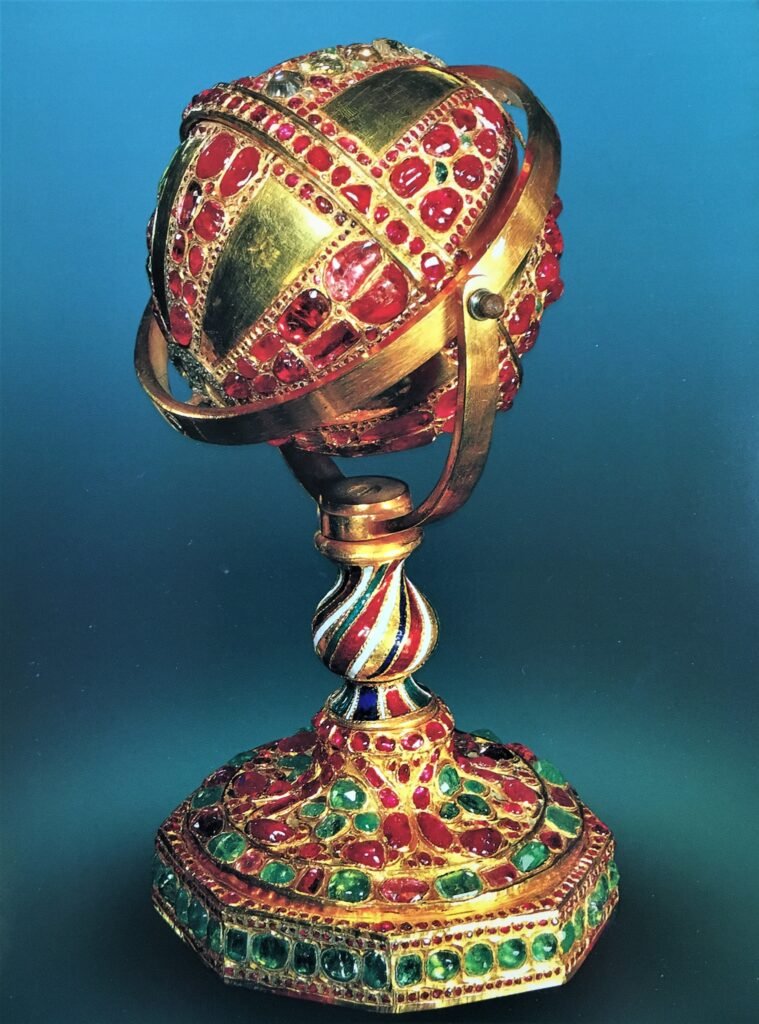
Case No.14: Table decoration made in 1870 
Case No.15: Coronation cloak used by Pahlavi family made in 1925
CASE NO.17
Nadir Throne
The present throne, although named after Nadir, has no relation to him whatsoever. There is persuasive evidence that it was constructed during the reign of Fath-Ali Shah (1798-1834 A.D.). The panels, located around the seat of throne, contain inscriptions which attribute the construction of this throne to Fath-Ali Shah.
The motive of Fath-Ali Shah in having this throne made, was to display the pomp and splendor of his court to his subjects, as well as, to foreign envoys who visited the king in various summer residences around Tehran. For this purpose, this throne is composed of 12 separate parts of precious stones set on the throne amounts to 26,733. This throne was used in the coronation ceremony of Mohammad Reza Pahlavi.
CAE NO.19
This case contains the hat of Abbas Mirza, garments of the Qajar period, a robe of gold, pearls and bead embroidery (item 6) and other objects. The hat of Abbas Mirza (item 20), in the shape of a crown, is made of red satin and velvet cloth that has been swon with pearls and gold sequins. On top is a large emerald set with diamonds. This hat was used by Abbas Mirza, crown prince of Fath-Ali Shah, on official occasions. (Made in Iran, early 19th century)
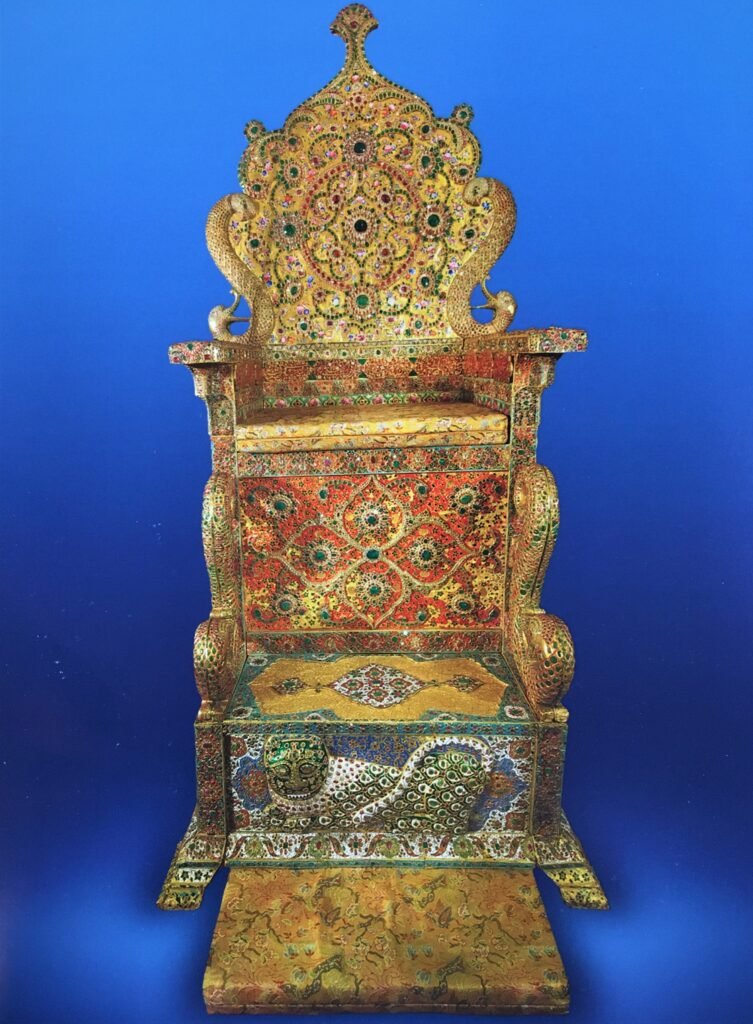
Case No.17: Nadir Throne made in early 19th century 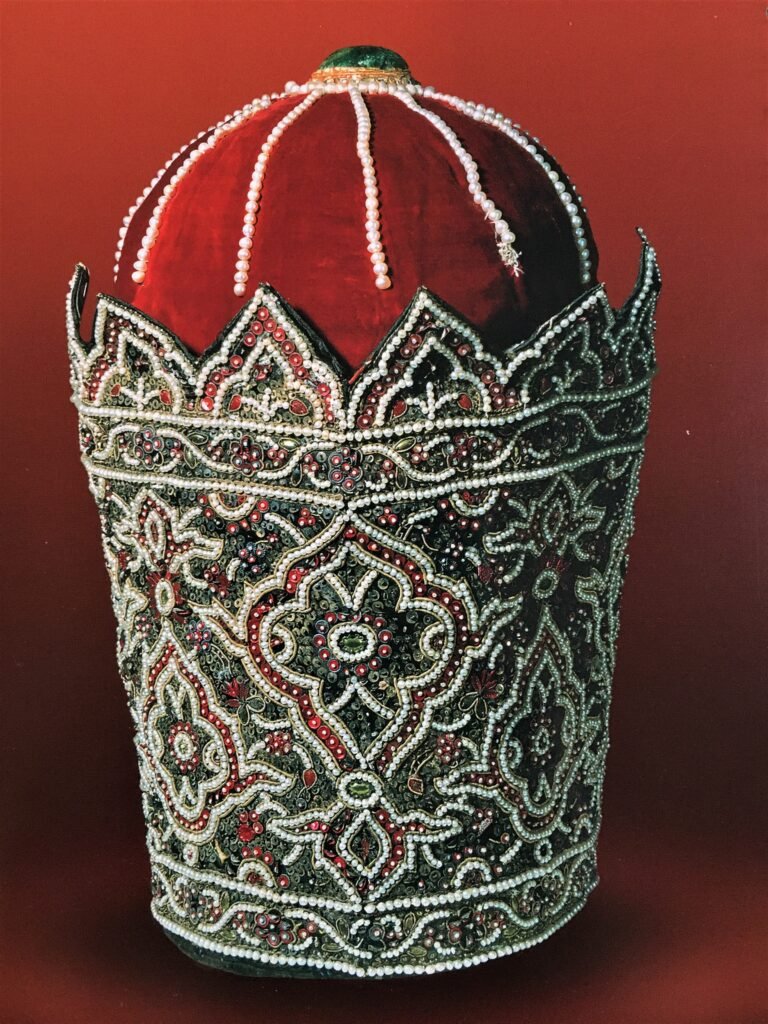
Case No.19: Hat used by Abbas Mirza, the Prince Royal, early 19th century
CASE NO.20
This case is devoted to various insignias and medals, some foreign made; as well as a number of gold boxes, brooches and inkpots.
- Item 31: Insignia, mounted with diamonds, presented by Alexander II the Tzar of Russia to Nasser-ed-din Shah.
- Item 99: Gold and enamel box presented by King Vittorio Emmanuele II of Italy to Nasser-ed-din Shah.
CASE NO.21
This case contains various boxes and watches.
- Item 1: Gold and enamel carafe. (Made in Iran, early 19th century)
- Item 3: Golden flowerpot with a flower bush totally set with diamonds and rubies. (Made in Iran, 19th century)
- Item 6: Holy Koran cover set with diamonds.
- Item 8: Gold Pocket watch set with diamonds and enamel. Gift of Queen Victoria to Nasser-ed-din Shah. (Made in England, 19th century)
CASE NO.22
This case is arranged with various bejeweled swords and daggers.
- Item 6: Sword presented by Alexander II the Czar of Russia to Iran.
- Item 13: A crupper with a 220-carat Topaz in the middle.
- Item 12: A horse aigrette set with diamonds and yellow sapphires.
CASE NO.23
In this case brooches, diamonds studded purses, armlets, bracelets and some other objects are displayed.
- Item 15: Three brooches with large pearls. The duck has a black pearl and the swans have white pearls.
- Item 19: An armlet set with five different colored stones of excellent quality.
- Item 69, 72, 78, 79: Brooches made of gold and enamel in the shape of bugs and flowers, each containing a tiny watch. (Made by Faberge in 19th century)
CASE NO.24
In this case, various diamonds, ranging in size from less than one caret to 152.16 carats, and with different cuts of the diamonds on display; from the simplest to very rare cuts like the Jubilee and Briolette.
Item 19: The “celebrated sword” of Nadir Shah. The scabbard of the sword is gold and set with 1869 rose cut diamonds. On the reverse side, there is an enameled portrait of Fath-Ali-Shah Qajar and the text “Al-Soltan Fath-Ali-Shah Qajar” also verses in calligraphy. This one of the famous national weapons of Iran. After the victories of Nadir Shah the sword was named “All Conquering Sword” and after the words were studded with diamonds and protected in the National Treasury of Iran.
Most of the recent kings including Reza Khan Pahlavi used it during his coronation in 1926 AD.
- Item 23: Several colored diamonds: three black, one red, two yellow and one peach. Item 24 has several high quality blue sapphires. The largest one weights 141.91 carats.
- Item 32 & 33: Diamonds from the Cape mines of South Africa. These diamonds were purchaised by Nasser-ed-din Shah on his third trip to Europe. These enormous diamonds are collectively reffered to as the “Iranian Yellows”. Five of the larger ones of these diamonds weigh 152.16, 135.34, 123.93, 114.28 and 121.90 carats. The latter, an octahedron, not cut, although it is faceted all over.
- Item 36: The middle large stone is the famous “Taj-i-Mah” (Mogul cut) diamond weighing 115 115.06 carats.
- Item 46: Four large colored stones; a blue sapphire of 192.58 carats, a yellow sapphire of 119.04 carats, a garnet of 130.57 carats and a chrysoberyl of 147.59 carats.

Case No.23: Three brooches with pearls, made in 19th century 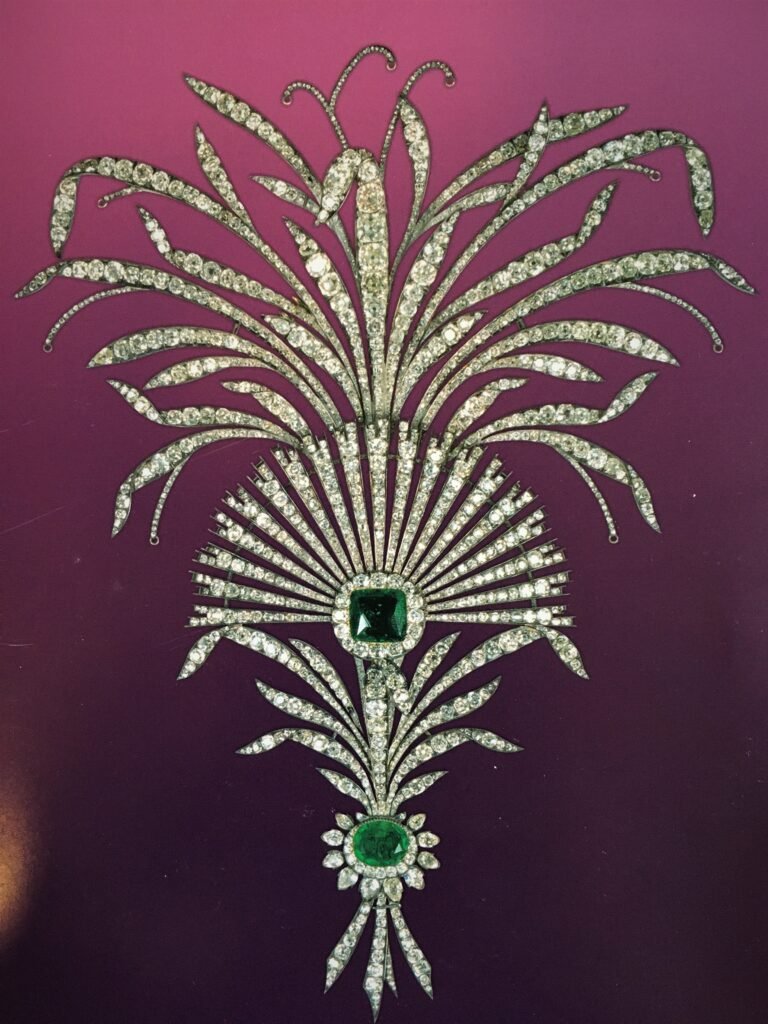
Case No.24: Aigrette made in second half of 19th century
CASE NO.25
This case is devoted to a rifle, a quiver, several swords and daggers, all encrusted with various gems.
CASE NO. 26
This case contains, jewels assigned for the use of Pahlavi family\. In 1938 AD, on occasion of the first wedding of Mohammad Reza Pahlavi, it was decided to make some jewels for the use of the family. Therefore, Iranian and French jewelers, under the supervision of a board, and several new pieces.
again, in 1958, some more pieces were made and in 1967 AD, on the occasions of coronation ceremonies, French jewelers made some other items. Unset stones from the Treasury were chosen in order to make these objects.
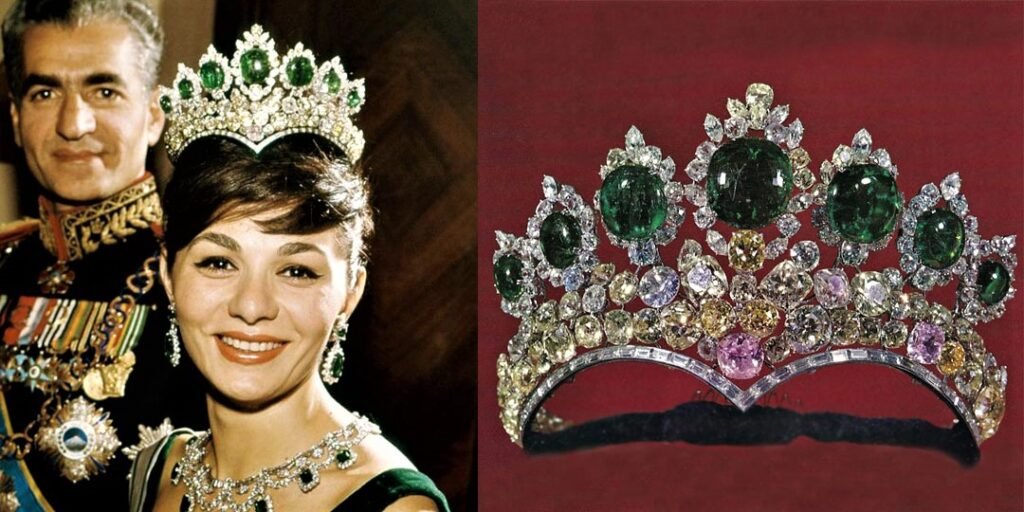
- Item 1: Platinum necklace set with 10 large emeralds, 486 diamonds and 4 huge pearls (two of which have 29 millimeters length). (Made in 1967)
- Item 2: Platinum tiara set with 324 diamonds. The 60-carat pale pink diamond is known as Nur-ol-Ayn is mounted in the middle front and was made in 1958.
- Item 9: Platinum necklace set with 246 diamonds. Seven yellow African diamonds (Made in 1967)
- Item 14: The tiara with 294 diamond and 7 emeralds made in 1958.
- Item 25: The platinum necklace set with 469 diamonds. The nine diamonds drops are Briolette cut. This cut for the diamonds is very rare. (Made in 1938)
- Item 38: Brooch set with Burmese rubies and diamonds was made in middle 19th century.
CASE NO.27
This case displays, loose emeralds weighing from 10 to 320 carats as well as objects set with emeralds.
- Item 1: A gold and green enameled bottle set with diamonds and rubies; the stopper is capped with a big ruby and ornamented with pearl drops. (Made in Iran, second half of 19th century)
- Item 5: Gold watch set with a 55-carat cabochon emerald.
- Item 11: Exquisite snuff box set with 92 matching emeralds of superb quality. It is thought to have been made in Iran during the first half of 19th century.
- Item 31: A clasp set with a very high quality cabochon emerald weighing 150-carats.
CASE NO.28
This case contains the buckler of Nadir Shah, and various bejeweled swords and daggers.
- Item 3: The shield of Nadir Shah is made of rhinoceros hide. It was used in the war with India in 1739-1740 and the huge rubies, diamonds, spinels and emeralds were added later to mark the occasion.
- Item 7: Sword with diamonds-studded hilt and a blade of Damascus steel. The scabbard is made of black leather. It is set with diamonds and golden tassel and clasps. This sword was presented by Sultan of Turkey to Nasser-ed-din Shah in 1860 AD.
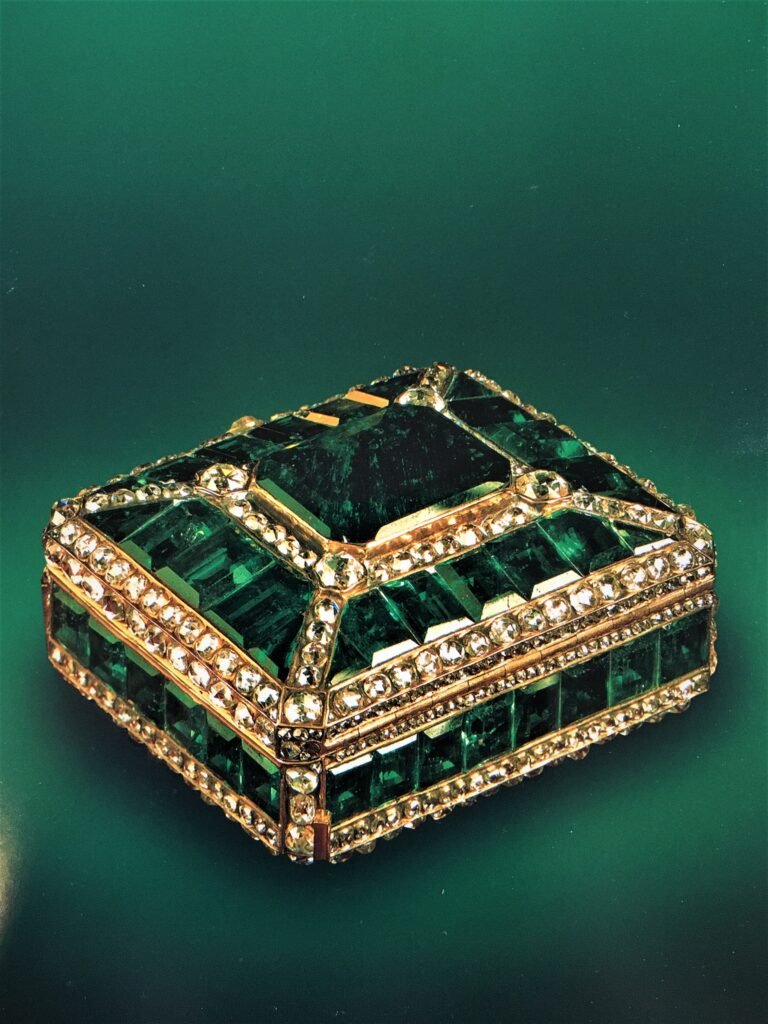
Case No.27: An emerald box, made in second half of 19th century 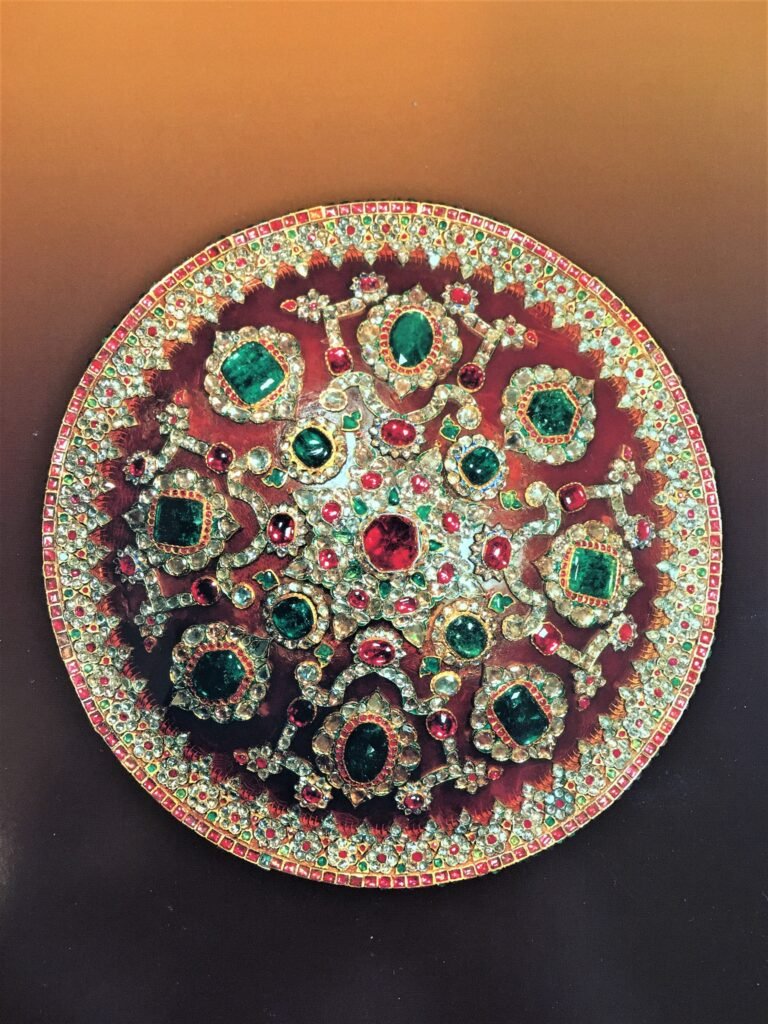
Case No.28: A rare decorated buckler, early 19th century
CASE NO.29
In this case an enamelled gold ewer and basin (Item 15). The travelling mirror of Fath-Ali Shah (Item 28). Various gold coffee cup holders, belts (Item 45 and 58). A pair of diamond and sapphire clasps and some other objects are displayed.
CASE NO.30
This case is assigned to cut and uncut emeralds and objects set with emeralds.
- Item 5: Tiara set with diamonds and one emerald presented by the British government during the reign of Fath_Ali Shah. (Made in England, early 19th century)
- Item 35: Poniard with gold sheath, one side of which is engraved and set with emeralds. The blade of this poniard which was made in the Caucuses was presented by Haji Reza Qoli, the butler, during a trip to Moghan. This poniard was made by Sani-ol-Mamalek in 1896 and decorated with emeralds two years after the coronation of Mozafar-ed-din Shah.
- Item 48: Sword with sheath, handle and hand guard is gold, and set with emeralds, spinels, sapphires, rubies and diamonds. On the reverse, there’s an inscription praising the august standing of the king, signed by the royal gold smith, Mirza Alinaghi, and dated 1306 LH (1888 A.D.). This sword was presented by the Prime Minister, Mirza Ali Asghar Amin-ol-Soltan, Atabak Azam, to Nasser-ed-din Shah in 1894 AD. This sword was used in the coronation ceremony by Mohammad Reza Pahlavi 1967 D.
CASE NO.31
This case is mainly arranged with enameled gold objects, such as Kalyan (waterpipes) parts, dish-cover, trays and bottles.
- Item 11: Gold and enameled carafe. (Made in Iran, 18th century)
- Item 31: Gold decanter with flowers made of green and white enamel. (Made in India, 17th century)
- Item 33: Gold ewer and basin covered with enamel, decorated with flowers and animal motifs. (Made in Iran, 19th century)
- Item 34: Gold tray delicately enameled by Mirza Baba, a famous painter during the reign of Fath-Ali Shah. The inscriptions in the middle of the tray include praise of Fath-Ali Shah. (Made in Iran, 1827 A.D.)
CASE NO.32
Various dish-covers, coffee cup holders and a golden candlestick are displayed in this case. The twin of this candlestick is in the case No.3.
CASE NO.33
This case presents various objects decorated with precious stones, such as carafe, ewer and basin, mirrors, kalyan heads, dish-covers, knives and knife handles and bowls.
- Item 18: Gold ewer and basin set with emeralds, rubies and diamonds. The mouth of the ewer is set with a ring of pearls (Made in Iran, mid-19th century)
- Item 19: Golden rose-water sprinkler enameled and set with rubies, diamonds and emeralds.
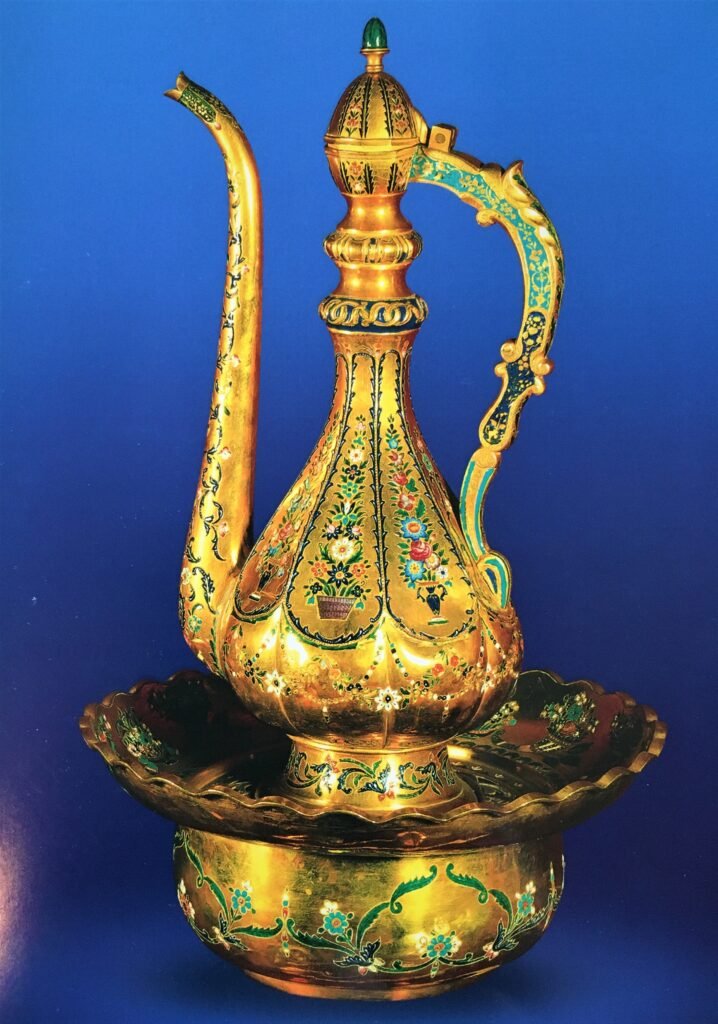
Case No.29: Ewer and basin for washing hands, made in early 19th century 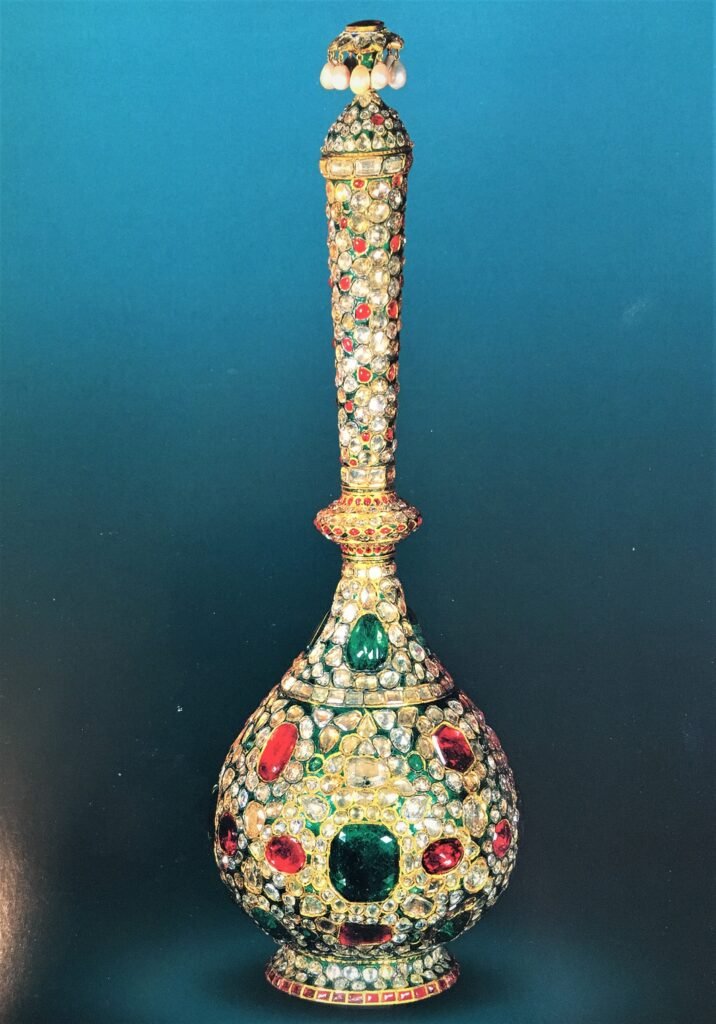
Case No.33: Bottle, made in second half of 19th century
CASE NO.34
- Item 1: Crown used by Reza Khan and Mohammad Reza Pahlavi. This crown is made of gold and silver, and decorated with diamonds, emeralds, sapphires and pearls. The fabric of the crown is red velvet. On the 4 sides of the crown are battlement designs and also sunbursts on the four panels, totally set in diamonds. The general design is in the style of the crowns of the Sassanid Kings (226-651 A.D.). Inside the front sun design, there’s an enormous yellow diamond. The total number of the precious stones set in this crown is as follows:
- Diamonds: 3,380 pieces; 1,144 carats
- Emeralds: 5 pieces; 199 carats
- Sapphires: 2 pieces; 19 carats
- Pearls: 368 pieces; perfectly matching
Total weight of the crown is 2,080 grams.
The crown used during the coronation of the Qajar kings, was the Kiani Crown, but Reza Khan Pahlavi did not use it. In 1925 AD, a group of Iranian jewelers, under the supervision of Haj Seraj-ed-din (the famous jeweler who had been jeweler to the Amir of Bukhara, and had emigrated from Russia to Iran), undertook to make this crown, using selected stones from the treasury. This crown was used in the coronation of Mohammad Reza Pahlavi on October 26, 1967 AD.

CASE NO.34
- Item 2: The famous Darya-i-Nur or Sea of Light is the largest pink diamond of the world and takes the first place among the diamonds in the National Treasury of Iran. The Darya-i-Nur diamond was inherited by Shahrokh Mirza, the grandson of Nadir Shah. It then came into the possession of Amir Alam Khan Khozaimeh, and later Lotf-Ali Khan Zand. When Agha Mohammad Khan Qajar defeated Lotf-Ali Khan, this diamond came into the treasury of Qajar kings. Nasser-ed-din Shah believed that this diamond was one of the gems decorating the crown of Cyrus (58 to 529 BC). And was very fond of it. He wrote it as an aigrette. The maintenance of Darya-i-Nur was a high special honor bestowed upon high-ranking personages. Darya-i-Nur later entered the Treasury of National Jewels of Iran. The weight of Darya-i-Nur is approximately 182-carats, and its color is pale pink, one of the rare colors of diamonds.
The frame is set with 475 diamonds and 4 rubies. In 1965, during the research by Canadian team on the Iran National Jewels, they revealed an interesting point. The famous French jeweler and traveler, Tavernier, mentions in his book, that he has seen a large pink diamond, weighing 242-carats, in the east, in 1642. He named it “Diamanta Grande Table”. The color and size of this diamond caught the attention of this Canadian team, and they believed that Darya-i-Nur and Nur-ol-Ein were originally one stone, that later got split into two stones. One part became the Darya-i-Nur, and part the 60-carat Nur-ol-Ein that is presently mounted in Tiara No.2 displayed in Case 26.
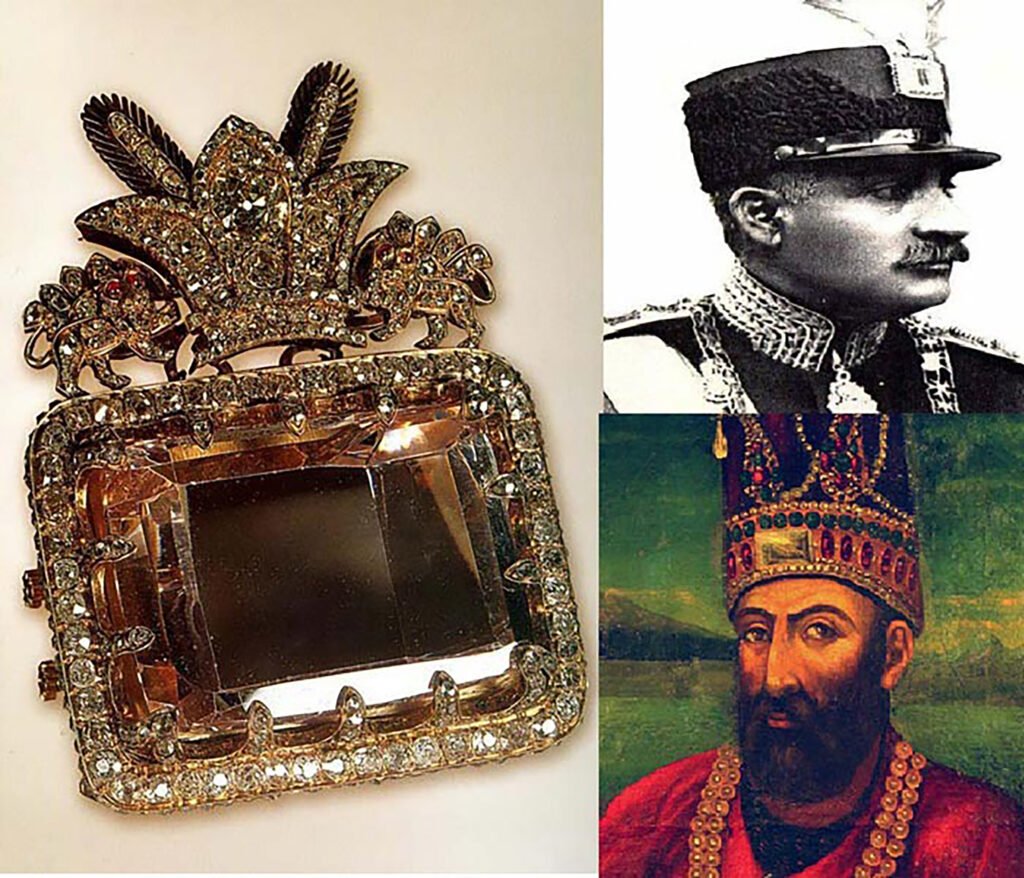
CASE NO.34
Item 3. A golden belt with a large emerald of 175.5 carats set in the buckle, surrounded by 60 brilliant cut diamonds and 145 rose cut diamonds. Its total length is 119 centimeters and the width 4 centimeters. There are clasps for adjusting the belt. It was used in the coronation of Reza Khan Pahlavi in 1926 AD, and with a slight adjustment, reused in the coronation of Mohammad Reza Pahlavi in 1967 AD (Made in Iran, late 19th century)
- Item 4: The Nadir aigrette, set with diamonds and emeralds. The central emerald is cabochon with a very good color, 3 drop emeralds hang from the aigrette. There are seven diamonds studded plumes on this aigrette. At the base of two of these plumes, there are two flowers and at ends, 2 emerald drops. On both sides of the central emerald and bellow the crescent, there are flags, drums, cannons, and spears. The tri-colored flags have pale rubies and emeralds. The whole aigrette is set with very good, rose cut diamonds. Reza Khan Pahlavi often used this aigrette, which weights 781 carats (Made in Iran, 19th century)
- Item 5: The royal scepter made of gold and diamonds was presented by the people of Azerbaijan in the coronation held on April 25, 1926 AD. This scepter measures 79 centimeters long. At the top of the scepter is a globe marked with geographic designs bearing the name of the continents. Three lions and suns support a diamond-studded crown with their right paws. The scepter bears certain verses from the Koran, as well as laudatory verses in praise of Reza Khan Pahlavi (Made in Tabriz, 1925 AD)
- Item 6: A pair of epaulets made of gold thread and each of them mounted with 2 large emeralds, made in 1967 AD, for the coronation of Mohammad Reza Pahlavi.

Case No.34: Nadi aigrette, made in second half of 19th century 
Ornamented tiaras crafted in different countries
CASE NO. 35
- Item 1: Crown used by Farah Pahlavi. The crown has been made using selected gems from the Treasury, by Van Cleef et Arpels in 1967.
The crown is made of platinum, gold and the following stones:
- Diamonds: 1,469 pieces
- Emeralds: 36 pieces
- Pearls: 105 pieces
- Rubies: 34 pieces
- Spinels: 2 pieces
Total weight of the crown is 1,480.90 grams.
- Item 4: This buckle is made of 84 cabochon cut rubies, of outstanding quality, brought from Myanmar.
CASE NO.36
Item 1: Crown of Fath-Ali Shah Qajar known as “Kiani Crown and set with diamonds, emeralds, rubies and pearls. The final red stone is Aurangzeb spinel. This crown was made during the reign of Fath-Ali Shah, and used by some of the succeeding kings. It is the first crown made after the Sassanid dynasty (Made in Iran, 1797 A.D.)
- Item 4: A mace made at the same time as the Kiani Crown. It is set with spinels and diamonds.

Case No.35: Crown used by Farah Pahlavi, made in 1967 
Case No.36: Kiani Crown early 19th century
CASE NO.37
Globe of Jewels
This globe of jewels was begun in 1869 AD by Nasser-ed-din Shah, a group of Iranian craftsmen, under the supervision of Ebrahim Massihi, made this globe using the loose stones of the Treasury. The net gold used in this Globe is 34.00 kilograms and the total weight of the stones is 3,656 grams. The total number of the stones used is 51,366 pieces. Finding the different countries can be difficult among the sparkle of the gems, because the skill of the craftsmen was more in jewelry making than in geography. The ocean and the seas are identified in emeralds and lands are shown in rubies. South-east Asia, Iran, England and France are specified with diamonds. India is shown in pale rubies. Central and South Africa are shown in sapphires. The equator as well as other geographical lines in diamonds and rubies. The diameter of the Globe is about 66 centimeters. The stand is made of gold on wood and studded with gems.
Peacock Throne (Sun Throne)
During the reign of the Fath-Ali Shah and by his order, a great throne was made under the supervision of Hossein Khan Sadr Esfahani, the governer of Isfahan, using gold and loose stones of the Treasury (early 19th century).
As a design of sun encrusted with precious stones was used at the back panel of the throne, it became famous as the “Sun Throne”. After the marriage of Fath-Ali Shah with Tavous Tajodowleh, due to her name, the throne was named Peacock Throne. Some Iranians thought that the above throne was the same brought from India, but according to the description of Tavernier from Peacock Throne and their own gathering, they concluded that it could not be the genuine Peacock Throne.
In order to confirm this view, they discussed the matter with Nasser-ed-din Shah and at last became sure that this Peacock Throne was constructed by the order of Fath-Ali Shah and was named after his favourite wife Tavous Khanoom or Lady Peacock as Peacock Throne. After the death of Fath-Ali Shah and some years later, as Nasser-ed-din Shah loved jewels, ordered to repair the throne by making some small changes in it. Therefore, some panels were added to the throne, depicting verses, which confirm the repairment of the throne by Nasser-ed-din Shah. The verses are in blue enamel on a golden background. The verses are arranged very regularly and reveals the fact that they are added to the thorne during its repair.
The peacock throne was kept in Golestan Palace until 1360 (1981 A.D.) On 1360/06/17 (6th September 1981) the throne was delivered to the National Jewels located in the Central Bank of Islamic Republic of Iran, to be kept in a place with similarity with the other pieces of the collection due to its rich accumulation of jewels. (Subject of the law approved in 1316 = 1927 A.D.)
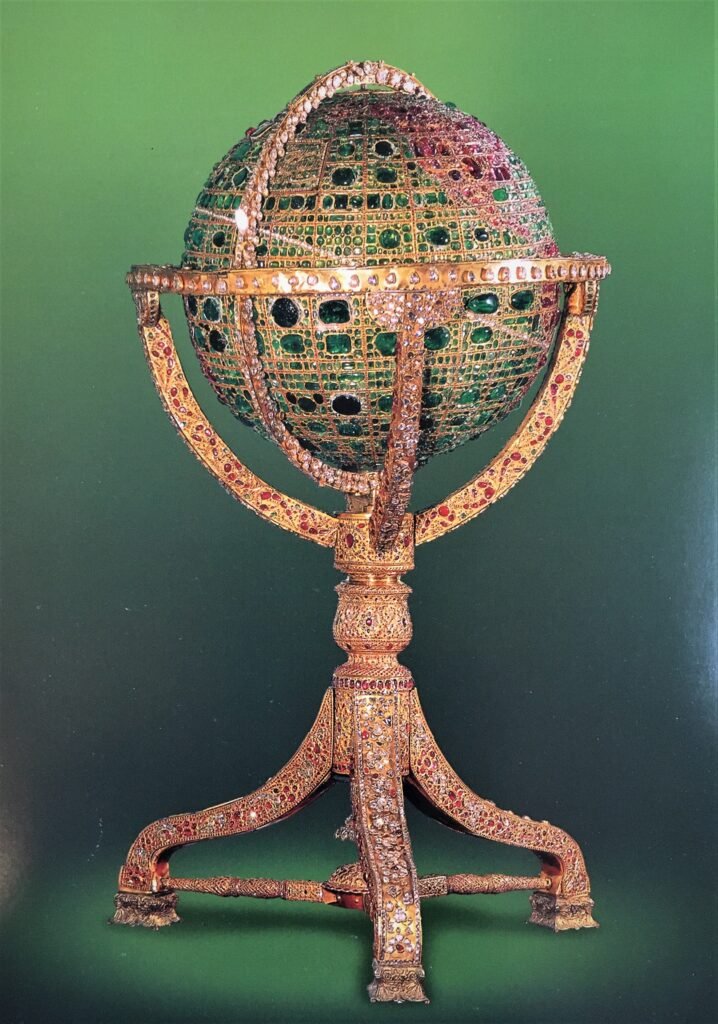
Case No.37: The jeweled globe, made in second half of 19th century 
The Sun or Peacock Throne, made in early 19th century
Opening Hours
- Saturday to Tuesday | 14:00-17:00
- Ticket Counter closes at 16:30
The Treasury of National Jewels is closed on Wednesdays, Thursdays and Fridays, and on National Official Holidays.
Recourse: Central Bank of Islamic Republic of Iran
Writer: Golnar ZAMANI
Book Your Stay at Hi Tehran Hostel Now
Book your stay at HI Tehran Hostel , Also if you have climbing and trekking in Iran on your mind, our guide will help you! You Are Invited!


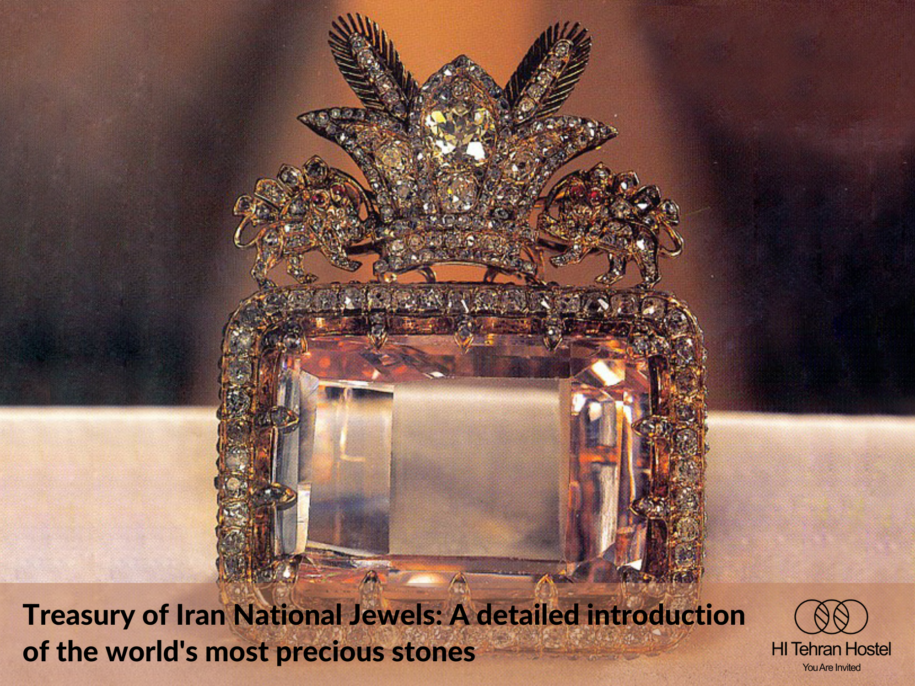
2 Comments
Philipe
We went there while exploring Tehran. The security was amazing. Looking upon those treasures was breathtaking
Hi Tehran Hostel
It is for sure one of the bests – if not the best jewel treasury in the world.